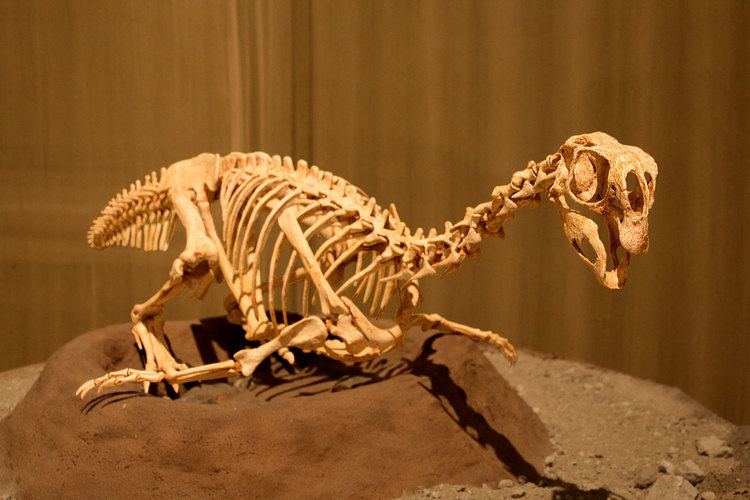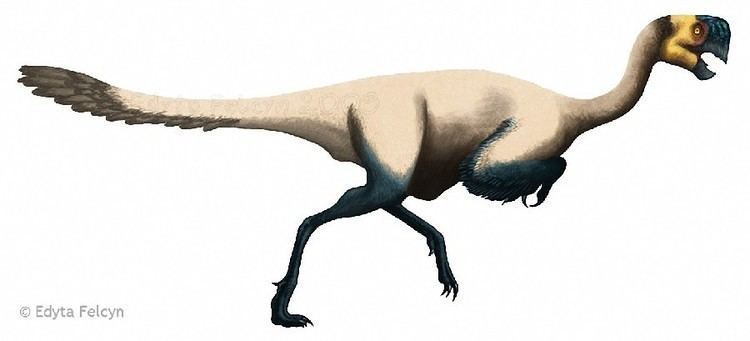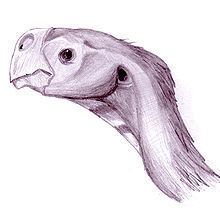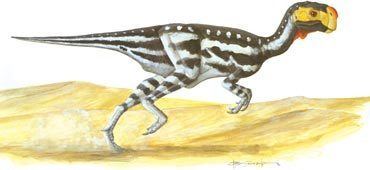Scientific name Conchoraptor gracilis Rank Genus | Class Reptilia Species †C. gracilis Phylum Chordata | |
 | ||
Similar Ajancingenia, Chirostenotes, Anserimimus, Elmisaurus, Khaan | ||
Conchoraptor (meaning "conch plunderer") is a genus of oviraptorid dinosaur from the late Cretaceous Period of what is now Asia.
Contents

Tribute to conchoraptor
Description

Conchoraptor was a small dinosaur, only 1–2 meters (3.3-6.6 feet) in length. Unlike many other oviraptorids, Conchoraptor lacked a head crest. Like its relatives, it lacked teeth. Instead of teeth, oviraptorids had powerful beaks, possibly adapted to crushing mollusk shells. The skull of Conchoraptor was heavily pneumatised, with most of the bones hollow. Internal connections between both ears functioned as resonance chambers and improved hearing.
Discovery

When first discovered in the Red Beds of Hermiin Tsav of the Late Campanian Nemegt Formation by a Polish-Mongolian expedition in 1971, scientists believed that Conchoraptor was a juvenile Oviraptor and that the animal's missing crest would have begun to grow when the animal reaching sexual maturity. Further study of multiple skeletons showed that Conchoraptor belonged in a new genus. The hands of Conchoraptor were a major reason that scientists decided to split it off from Oviraptor. Anatomically the hands seemed to be an evolutionary intermediate between those of Ajancingenia and Oviraptor, making it obvious that this animal was not a member of a known species.
The type species of this new genus, Conchoraptor gracilis, was described and named by Barsbold, in 1986. The generic name is derived from Greek konkhè, "mussel", and Latin raptor, "plunderer". This name reflects Barsbold's hypothesis that oviraptorids, rather than preying primarily upon eggs as had been traditionally thought, may have been specialized to feed on mollusks. The specific name means "gracile" in Latin. The holotype is IGM 100/20, a partial skeleton with skull. Later about two dozen specimens were formally referred to the species.
Classification
Conchoraptor was by Barsbold assigned to the Oviraptoridae in 1986. Recent analyses show it was a member of the oviraptorid subfamily Ingeniinae.
The cladogram below follows an analysis by Fanti et al., 2012.
Habitat
The Barun Goyot Formation of Mongolia, is estimated to date back to the Campanian stage, between 84 and 70 million years ago of the Late Cretaceous period. During the Late Cretaceous period, the land that is now the Barun Goyot Formation had an arid environment with fields of sand dunes and only intermittent streams. It is slightly younger than the nearby Djadochta Formation, and seems to have been slightly wetter. This formation is noteworthy for the exquisite preservation of small and fragile dinosaur skeletons, a rare occurrence considering that these fossils are typically broken up and dispersed when found in other rock formations.
Paleofauna
Conchoraptor shared its paleoenvironment with the maniraptoran Hulsanpes perlei, the oviraptorid Ajancingenia yanshini, the avimimid Avimimus, the alvarezsaurids Ceratonykus oculatus, Mononykus and Parvicursor remotus, the pachycephalosaur Tylocephale gilmorei, the ankylosaurs Saichania chulsanensis and Tarchia gigantea, and the ceratopsians Bagaceratops rozhdestvenskyi, Breviceratops kozlowskii, Lamaceratops tereschenkoi and Platyceratops tatarinovi. The largest dinosaur among them was the titanosaur Quaesitosaurus orientalis. It was observed that many of the same genera were present at the Barun Goyot and Djadochta Formations, though there was variation at the species level. Vertebrates present in the Barun Goyot Formation included the primitive birds Gobipteryx minuta and Hollanda luceria and the lizards Estesia mongoliensis, Ovoo gurvel, Proplatynotia longirostrata and Gobiderma pulchrum. The early mammals that were present in this region during the time of Conchoraptor were the placental mammals Asioryctes nemegetensis and Barunlestes butleri, the amphibian Gobiates khermeentsavi, the multituberculate mammals Catopsbaatar catopsaloides, Chulsanbaatar vulgaris and Nemegtbaatar gobiensis, and the marsupial mammal Asiatherium reshetovi and Deltatheridium pretrituberculare. Numerous dinosaurs eggshells found in this region support the presence of sauropods and maniraptors.
